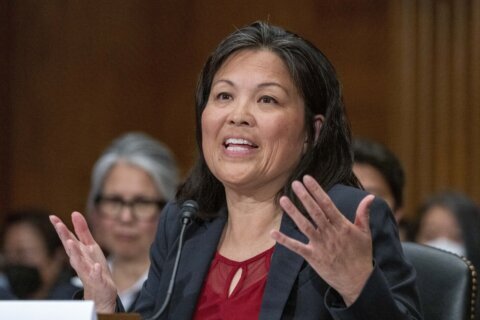The Biden administration’s pledge to assist Afghans who worked for, and on behalf of, the US government and military has raised questions about what the processing, screening and vetting protocol looks for applicants looking to relocate to the US amid the evacuation scramble.
While the Afghan Special Immigrant Visa (SIV) program has existed since 2009, the fall of Afghanistan to the Taliban has brought a stress test to the program it’s never seen before.
Here’s what you need to know:
What is an Afghan Special Immigrant Visa?
The Special Immigrant Visa program is meant to provide a pathway to the United States for Afghans who were employed by or worked on behalf of the US government.
What is the US’ vetting process for SIV applicants?
There is a lengthy multi-step process for SIV applicants to apply for visas to the US. Applicants must meet certain employment qualifications and provide supporting documents, including proof of employment, a letter of recommendation, and evidence of Afghan nationality.
For the most part, SIV applicants are not being evacuated from Afghanistan directly to the US. Prior to the fall of Kabul, the US brought several flights of Afghan SIV applicants who were at the very end stages of the process and their family members to Fort Lee, Virginia, to finish the process.
Now, flights out of Kabul are transiting through countries like Qatar and Kuwait, where passengers are being processed. “Everyone is being vetted at some point, at least once or twice,” an administration official previously told CNN.
National security adviser Jake Sullivan told reporters on Monday that this vetting includes “biometric and biographic background checks” that must be cleared before Afghan evacuees can be brought to the US or relocated to another country. Biometric vetting often refers to voiceprints, iris scans, palm prints and facial photos.
State Department spokesman Ned Price also said Monday, “When it comes to SIVs, again, all of those who have received instructions to come to the airport have already completed certain stages of the security vetting process.”
“So that initial vet on these individuals has been completed. In many cases, they’re then taken to a third country, where they will undergo more rigorous vetting if it hasn’t yet been completed,” Price said.
And as Sunil Varghese, policy director at the International Refugee Assistance Project — which represents Special Immigrant Visa applicants and refugees, told CNN, SIV applicants are not “a random group.”
“I think people should know about vetting this population is that oftentimes — people who worked with Afghans in Afghanistan know this — the Afghans that we trust to work for the US go through so much vetting already as part of that job. We do a lot of vetting to make sure that our military, our ground troops’ eyes and ears can be trusted,” he said.
SIV applicants, he added, “are people who work side-by-side with Americans, and often who had to already be vetted just to get that job and serve.”
Congress passed bipartisan legislation as part of the supplemental security spending bill that is meant to improve and expedite the SIV program, and President Joe Biden signed it into law in late July.
The changes included lowering the eligibility requirement for applicants from two years to one year of service and waiving the medical evaluation, removing the requirement that those who were employed by the International Security Assistance Force and Resolute Support performed “sensitive and trusted” activities and changes to the process of appealing denials.
How long does the SIV application process take?
The SIV program has faced massive backlog and processing can take months, if not years for some. A State Department spokesperson said in mid-July that 20,000 applicants are in various stages of the SIV application process.
The administration has acknowledged these delays, but also said it inherited a massive backlog when Biden took office. The administration has taken some steps to address them, including a surge in State Department personnel to process visas, the Department of Homeland Security working overtime on security checks, and assistance from the Department of Defense as the situation on the ground in Afghanistan deteriorated.
“The program from the outset was plagued with administrative errors and lengthy backlogs. It was narrowly interpreted and left out a lot of people who worked on behalf of the US,” Varghese told CNN on Monday.
“So many of our clients, the reason that they’re stuck in the SIV process for years on years is because they’re stuck in the vetting process. The US vetting — it’s basically a black box. You put your name in and you hope the name comes out. You don’t know what’s happening and you don’t know why it’s taking years.”
What’s the situation in Kabul for SIV applicants?
Many Afghans have been unable to reach evacuation flights amid chaos and confusion at the airport, and the US Embassy has now instructed everyone — including SIV recipients — not to report to the airport until given specific instructions to do so.
In a notice posted Sunday, the embassy advised that SIV applicants “will be given instructions on next steps.”
“Please understand, however, that this process may take an extended period,” it said.
The US is also prioritizing American citizens and legal permanent residents for entrance to the airport, John Johnson, public affairs officer for the US Embassy in Kabul, told CNN Monday. “Due to a deteriorating security environment we are asking all others not to come to the airport at this time — the gates remain closed.”
What is the Biden administration saying?
Biden administration officials have repeatedly said they are committed to helping Afghans who worked for the US in its twenty year military campaign in Afghanistan.
On Sunday, Secretary of State Antony Blinken said that “when it comes to the Special Immigrant Visa program — these are the folks who helped us, who stood with us, translators, interpreters, et cetera, who we’ve committed to bringing out of Afghanistan if they want to leave,” and defended the Biden administration’s actions in the lead up to the fall of Kabul but acknowledged that those efforts were not the same as “a full-on evacuation.”
He indicated that the administration thought it would have more time to execute on those efforts to relocate the Afghans and their families who worked alongside the US government.
“Because we believed that the government was not about, was not going to collapse, the military was not about to fade away when it did, we believed that we could do this with, in a very expedited way, more resources, more effort, more people out, but that we would have time to do it effectively,” he said on “Fox News Sunday.”
Biden said in remarks from the White House on Sunday that “once screened and cleared, we will welcome these Afghans, who helped us in the war effort over the last 20 years, to their new home in the United States of America.”
“Because that’s who we are,” Biden said. “That’s what America is.”
What are the other ways for Afghan refugees to come to the US?
Administration officials have said they are working to relocate “vulnerable Afghans” from Afghanistan, and in early August announced it would expand access to the refugee program for Afghans who do not qualify for SIVs.
These Afghans, including those who worked for US-based media companies or NGOs, are now eligible for “Priority 2” or “P2” designation, which applies to “groups of special concern designated by the Department of State as having access to the program by virtue of their circumstances and apparent need for resettlement.”
There was also an existing “Priority 1” designation under the US Refugee Admissions Program.
“We are urgently working on efforts to assist eligible Afghans under the Afghan Special Immigrant Visa program, Priority 1 (P-1) and Priority 2 (P-2) referrals to the U.S. Refugee Admissions Program, and humanitarian parole,” Price said last week.
The-CNN-Wire
™ & © 2021 Cable News Network, Inc., a WarnerMedia Company. All rights reserved.







